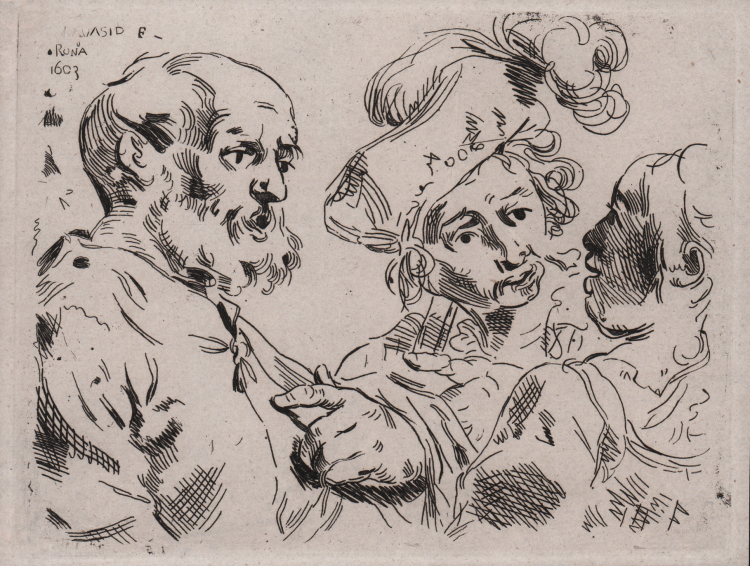



| Reference: | S45337 |
| Author | William Young OTTLEY |
| Year: | 1828 |
| Measures: | 145 x 110 mm |


| Reference: | S45337 |
| Author | William Young OTTLEY |
| Year: | 1828 |
| Measures: | 145 x 110 mm |
The denial of St Peter: three busts, a woman on the right, in profile, being questioned by the officer in the middle who points at St Peter on the left; a copy of the etching attributed to Caravaggio.
Etching, printed on chine collé, 1828, lettered at top left: '[Ca]ravasid [sic] F / Rona [sic] / 1603'.
From A collection of thirty-nine facsimiles of rare etchings, London 1828.
This print was long thought to be the only etching by Caravaggio. Recently Vignon has been suggested as an alternative.
“The immediacy and intensity of the confrontation in this print, as well as the directness and economy of the draftsmanship, suggest that it was made by a creative artist. Moreover, the simple, single-bite etching and the technical difficulty of foul biting suggest an early, if not first, attempt at etching by a painter. As all four Gospels relate, Peter waited outside the house of Caiaphas the high priest, where Jesus was held for questioning. Identified by a serving maid as a follower of Jesus, Peter three times denied being his disciple. In this depiction a somewhat slow-witted soldier gapes at the servant, who has uttered her words of recognition, while Peter, openmouthed and pointing to himself, has already denied his involvement. The eye contact connecting the three participants is clearly conveyed and strongly felt. The subject is not known to have been painted by Caravaggio until after his departure from Rome; how- ever, he had painted similar compositions with half- length figures between 1602 and 1604, including The Incredulity of Thomas and The Calling of Peter and Andrew.' Followers of Caravaggio transformed the subject of his painting of The Calling of Saint Matthew to The Denial of Saint Peter. The date of 1603 on the print is a reasonable one, considering that its design and its convincing narrative, realism, and immediacy are in keeping with Caravaggio's innovative Roman paintings. Even the underlying facial structures and the shapes of the eye sockets are not dissimilar to the draftsmanship of Caravaggio's thinly painted late works. Modern scholars of Caravaggio's paintings have been skeptical of his authorship of this etching, while print specialists have been more lenient in their acceptance. No existing drawings can convincingly be attributed to Caravaggio, and no painted original, copy, or variant of the precise subject and composition is known, making a firm attribution extremely difficult. It does not seem wise to dismiss the opinions of a number of scholars who have suggested Claude Vignon as the author of this print. Vignon worked in Rome from 1609 (at the earliest) until 1622. There is an undeniable technical similarity between The Denial of Saint Peter and Vignon's Peter and Paul in a Common Grave, etched in 1620 . They have in common a simple, open linearity, speckled foul biting, and a similar manner of inscription. Vignon's chameleon-like personality during his Roman years, and his emulation of Caravaggio, have been substantiated. Yet The Denial of Saint Peter possesses a fluidity and an economy of line that are not as pronounced in Peter and Paul. Vignon's angel was awkwardly drawn, and his execution of the print generally more labored and angular. Moreover, Vignon's prints and Roman paintings lack the emotional concentration and rationality of The Denial of Saint Peter” (cf. Sue Welsh Reed in 'Italian etchers of the Renaissance and Baroque', Boston 1989, cat.72).
A fine impression, on laid paper, with margins, very good condition.
Bibliographic references
De Vesme 1906, Le peintre-graveur italien, 1; Sue Welsh Reed in 'Italian etchers of the Renaissance and Baroque', Boston 1989, cat.72.
William Young OTTLEY (6 agosto 1771, Regno Unito - 26 maggio 1836, Londra, Regno Unito)
|
William Young Ottley was a British collector of and writer on art, amateur artist, and Keeper of the Department of Prints and Drawings at the British Museum. He was an early English enthusiast for 14th- and 15th-century Italian art, or the "Italian Primitives" as they were then often called. He spent the 1790s based in Rome, where he bought much art; this was sold for a considerable profit in 1801 after his return to London.
|
William Young OTTLEY (6 agosto 1771, Regno Unito - 26 maggio 1836, Londra, Regno Unito)
|
William Young Ottley was a British collector of and writer on art, amateur artist, and Keeper of the Department of Prints and Drawings at the British Museum. He was an early English enthusiast for 14th- and 15th-century Italian art, or the "Italian Primitives" as they were then often called. He spent the 1790s based in Rome, where he bought much art; this was sold for a considerable profit in 1801 after his return to London.
|